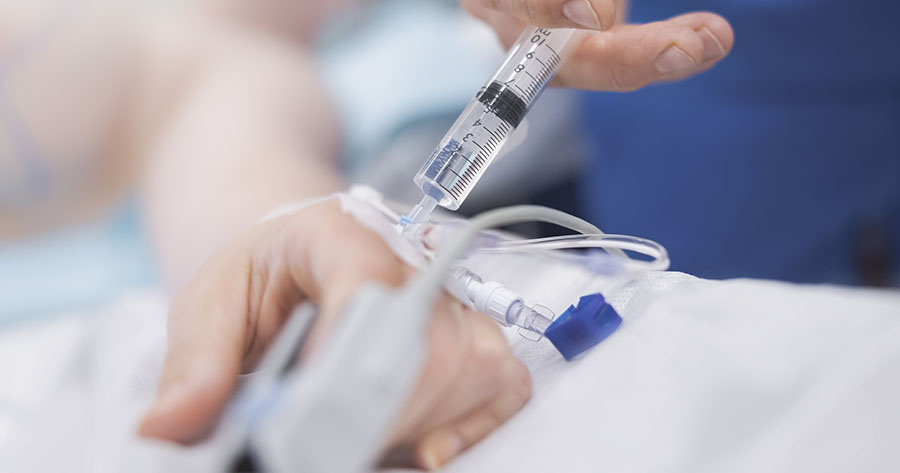The ThinkGlucose programme was launched by the NHS Institute for Innovation and Improvement in 2009, and was designed to improve the inpatient management of people with diabetes. A report from the National Diabetes Support Team in March 2008 stated that people with diabetes were twice as likely to be admitted to hospital and were likely to experience a longer hospital stay (National Diabetes Support Team, 2008). The same report also highlighted that people with diabetes were generally unhappy with the standard of diabetes care that they received while in hospital.
Introduction
St Richard’s Hospital in Chichester, West Sussex, is a district general hospital with 401 beds and currently has a 0.3 whole time equivalent (WTE) inpatient DSN.
The first National Diabetes Inpatient Audit was undertaken in September 2009. The results for St Richard’s Hospital showed that in the majority of areas audited it fell below the national average, especially in the areas of appropriate blood glucose monitoring with more inappropriate monitoring and a greater number of management errors.
Although the authors were keen to introduce the ThinkGlucose programme following attendance at one of the launch meetings, it was felt that resources needed to be focused. The article is discusses the experience of launching the ThinkGlucose programme.
Starting out
To effectively launch the programme with limited resources, it was decided to pilot the programme on two wards – one medical and one orthopaedic. It was thought that this would provide a realistic view of all the wards.
Following discussion with the diabetes nurse manager and diabetes consultants to highlight the potential benefits of delivering the ThinkGlucose campaign, a meeting with the ward sisters and ward dietitians was arranged to discuss the ThinkGlucose programme and to gain their support and engagement.
Although the National Diabetes Inpatient Audit data was useful, it provided only a snapshot of diabetes inpatient management. Therefore, to focus resources more effectively, it was decided to undertake a 3-month retrospective audit and assess current staff knowledge regarding diabetes and its management on both the wards chosen for the pilot.
Methodology
All patients admitted to both wards from 1 November 2009 to 31 January 2010 were recorded by the ward staff and their medical notes were then reviewed retrospectively. This established a reflection of current practice within the ward areas.
The audit tool was a questionnaire based on the National Diabetes Inpatient Audit tool (NHS Diabetes, 2009). It was designed to assess the management of diabetes during admission and the appropriateness of referrals to the specialist team.
In addition, a questionnaire was sent to all the ward staff. The aim was twofold – to review the ward staff’s knowledge and current practice, and to provide a structure for the teaching programme. This would ensure that the learning outcomes were deemed relevant by the students, which is essential if effective learning is to be achieved (Goodman-Brown, 2003). If the content is not deemed relevant or incorporating the knowledge into practice is seen as “impossible” the learning experience is a lost opportunity (Dickerson, 2003).
Results
Local audit results
The key audit results for November 2009–January 2010 are shown in Table 1.
The most startling result was the frequency and poor management of hypoglycaemia. In the majority of cases it was impossible to determine if hospital policy had been followed as no treatment was recorded in the patients notes; nursing, medical or end of bed charts. In some instances a blood glucose level was not rechecked for more than 4 hours after an episode of hypoglycaemia.
Questionnaire results
The staff questionnaire was sent out to all the ward staff during the data collection period. The response rate was disappointing in view of the ward manger’s support:
- Registered general nurses – 53.6% (15 of 28).
- Healthcare assistants – 28.6% (8 of 28).
- Housekeepers – 50.0% (2 of 4).
Overall, the response from the medical ward was higher than the orthopaedic ward, which may reflect the staff’s perception of the relevance of diabetes in their clinical area.
The housekeepers and healthcare assistants answered the same five questions regarding diet and diabetes, all of which were yes/no responses. The healthcare assistants also answered a question about the appropriate frequency of blood glucose monitoring.
The housekeepers demonstrated very good knowledge regarding diet while the healthcare assistants demonstrated a fair knowledge regarding diet and the appropriate frequency of blood glucose monitoring as per hospital policy.
The registered nurses questionnaire was scenario-based and designed to elicit knowledge and understanding of diabetes medications, management of hypoglycaemia and hyperglycaemia, and patient self-administration of insulin therapy. An example question is shown in Table 2.
The responses were variable. Generally nurses appeared to have a good understanding of the potential reasons for hyperglycaemia, but demonstrated a poor knowledge of insulin action and variable rate intravenous insulin infusions:
- Most of the nurse respondents (86.7%) were unclear on when a variable rate intravenous insulin infusion would be appropriate.
- Over half (60%) did not know when to safely stop the infusion.
- The morning dose of mixed insulin would be omitted by 50% of respondents if the patient was hypoglycaemic.
- Once daily insulin glargine would be omitted by 26.7% of nurses if the patient was hypoglycaemic at the time of administration.
- A blood glucose level would be rechecked by 80% of respondents within 30 minutes of treating an episode of hypoglycaemia, yet this was not reflected within the audit data collected.
Interventions
Two 3-hour teaching sessions were designed, incorporating a variety of teaching styles, focusing on the key issues highlighted in the audit data and responses to the staff questionnaires. Table 3 outlines the learning outcomes and attendance for each session.
The poor response to the questionnaires and the limited numbers who attended the teaching sessions was reasonable and expected in the current climate of short staffing and limited access to study leave.
Those who attended the sessions evaluated them positively and the key themes from the evaluations are shown in Table 5.
The greatest benefit from the teaching sessions was the opportunity to engage the ward staff in developing tools that would enable them to manage diabetes more effectively within the ward environment.
The tools developed in conjunction with the ward staff were the introduction of “hypo boxes” (Figure 1), insulin quick reference charts (A4 for the clinical room and credit card-sized to attach to ID badges), and hypoglycaemia posters for the clinical areas and patient charts.
To provide additional support to the staff, it was planned to visit each ward once a week. This seemed very logical at the time, but due to the DSN’s limited working hours (0.3 WTE), this soon proved to be very difficult with other work commitments.
Post-intervention audit
As previously, all patients admitted to both wards from 1 November 2010 to 31 January 2011 were audited retrospectively. The ward clerks noted all people with diabetes admitted during the period.
The key results are shown in Table 4. Pre- and post-intervention prescription and management errors are shown in Figures 2 and 3.
Discussion
The post-audit data demonstrated a clear improvement in the management of hypoglycaemia and reduced prescription errors, however it is impossible to directly link this to the teaching programme delivered. The National Patient Safety Agency’s Year of Insulin coincided with this audit and may account for the improvements in the prescription of insulin on wards.
The number of appropriate referrals to the diabetes team was reduced and this may reflect the ward staff’s increased confidence in managing diabetes – ward staff did report an increased confidence in managing diabetes following the programme.
The process enabled positive engagement with the ward staff in regard to the management of diabetes in the hospital setting, but was a time-consuming undertaking.
Unfortunately, due to staffing issues it has not been possible to widen the teaching programme to the other hospital wards, although all areas have received the tools developed. It is hoped that this can be addressed in the future.
Conclusion
The audit provided a valuable insight into the reality of current practice on the wards in relation to diabetes management. The teaching programme, with the support of the ward managers involved, was designed to reflect the key issues highlighted in the audit and the staff questionnaires.
The education sessions also provided an opportunity for the ward staff to be involved in the development of educational and therapeutic resources for their ward areas.
The involvement of the ward staff in the planning and development of the resources, in combination with the education sessions, is likely to increase the incorporation of new knowledge into clinical practice for the benefit of inpatients with diabetes.





The risk factors and what might be done to address them.
24 Mar 2025